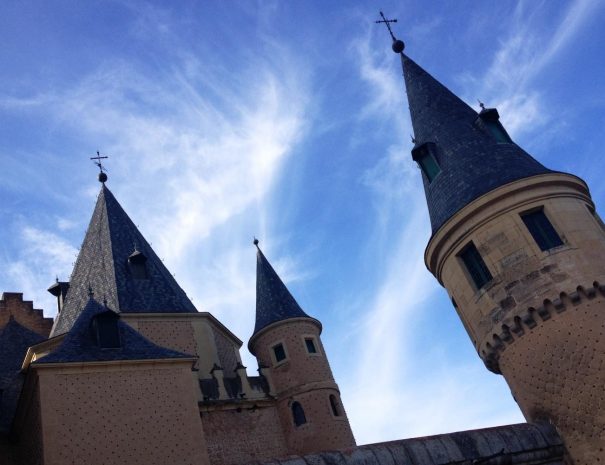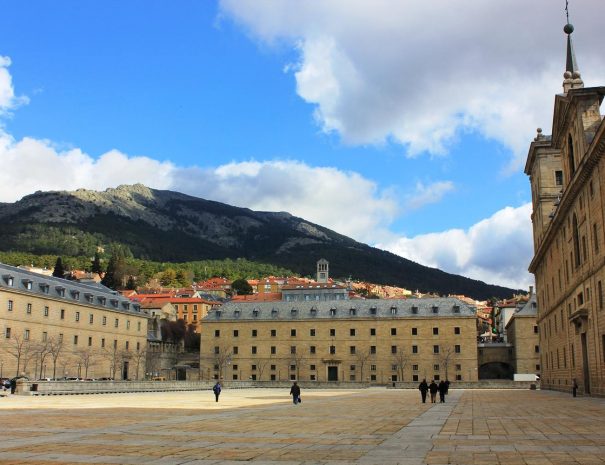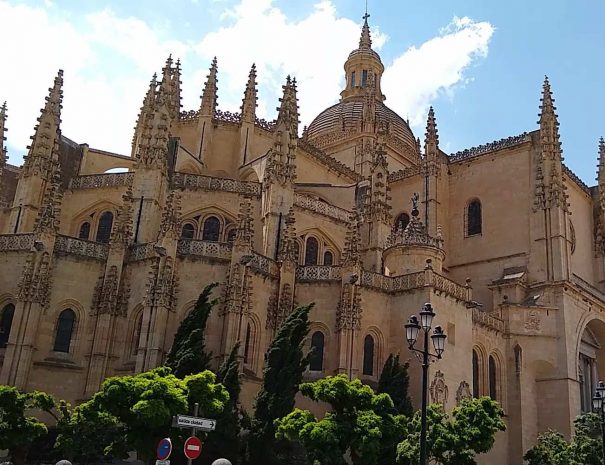Best way to enjoy a Tour to Segovia, Spain
The nearest airport to Segovia, Spain is Madrid. Madrid is located at a bit more than 1-hour drive from Segovia. There are 2 ways to reach Segovia by car. The simplest way is to make use of AP6 and AP61 (after a long tunnel in the Guadarrama mountains that is located between the Madrid and Castilla Leon regions)
We prefer and would recommend an alternative road through the National Park of Sierra de Guadarrama. You will need to take the AP6 but leave it at Collado Villalba (exit 39) and take CL 601 though the mountains. The road takes you as high as 1,800 meters height (almost 6,000 feet). This road is not advisable if you get sick on the road. If this is not the case, you would enjoy fantastic landscapes of pine forests, excellent views, and get the change to stop at small villages like Navacerrada, Valsain or La Granja de San Ildefonso (where one of the Spanish King’s summer houses is located and where you will find and be able to enjoy gardens that have little to envy those of Versailles.
Segovia can also be reached by train. The Fast train (AVE) connects Segovia with Madrid (the train station is Chamartin) in less than one hour. The train takes less than 30 minutes, but you should not be misled by this. Unfortunately the train station is not as close to Segovia as one would expect. It takes 90 minutes to walk from the station to the aqueduct for instance. There is a bus that will take you to the city center in 25 minutes (plus waiting time) so more than the time it takes the train to get you there. The most obvious option is to use a taxi that will take you to Segovia city center in 15 minutes.
The third option to get to Segovia is to use a tour. A private tour like the ones on this section are fantastic, but they are not suited for all budgets. There are however a good number of bus tours that can be enjoyed from Madrid to Segovia on a daily basis.
Where is Segovia, Spain located?
Segovia is situated in the autonomous region of Castile and León, nestled in the heart of Spain. It lies about 90 kilometers (56 miles) northwest of Madrid. The motorway is very good though there are more options to get to Segovia from Madrid (you can find more information on this above) This short distance and good connections makes it easily accessible from Madrid
Is one day enough to enjoy Segovia?
Though Segovia has lots to offer and 2 or 3 days could be spent here, most travellers opt for just a day trip from. There are many guided tours available to explore the city’s rich history. With such tours you would also avoid the hassle of changing accommodations and stay longer at the same hotel in Madrid.
What is the best season to visit Segovia?
Segovia´s weather is continental with both hot summers and cold winters. We believe the best time to enjoy Segovia (and central Spain ) are during the milder months of spring and autumn, particularly in April, May, September, and October, when the weather is pleasant. Since Segovia is a top local destination for people from Madrid, the city gets very hetic during Sundays and if possible, it is better to avoid Sundays.
How is the food from Segovia and traditional dishes?
The cuisine of Segovia is deeply rooted in its history and local ingredients. One of its most famous dishes is the succulent roast suckling pig, known locally and throughout Spain as “cochinillo asado.” This tender and flavorful delicacy is roasted whole until the skin is crispy and the meat tender, making it a must-try for visitors. Another traditional dish is the hearty “judiones de La Granja,” a stew made with large white beans, chorizo, and other meats, simmered to perfection. Segovia is also renowned for its ponche Segoviano, a very tasty yet heavy dessert.
What are the top highlights in Segovia?
Segovia is a Unesco heritage city and it boasts a wealth of architectural and historical treasures. Chief among is its iconic Roman aqueduct, an engineering marvel dating back to the 1st century AD. The Alcázar of Segovia, a fairy-tale castle perched atop a rocky promontory, offers panoramic views of the city and surrounding countryside and many say it inspired Disney. The Gothic-style Segovia Cathedral, with its soaring spires and intricate stained glass windows, is another must-see attraction (as a matter of fact it is the latest Gothic cathedral in Europe!). Visitors can also explore the quaint streets of the Jewish Quarter, where the legacy of Segovia’s medieval Jewish community is still evident. We also love its Plaza Mayor, great charm and a perfect place to enjoy a drink
Juan Bravo and Segovia’s history
While not an artist like El Greco in Toledo, Juan Bravo played a pivotal role in Segovia’s history as a leader of the comuneros during the Castilian War of the Communities in the 16th century. His courage and leadership are commemorated in Segovia’s Plaza de Juan Bravo, named in his honor.
Is Segovia a good city to enjoy Spain’s heritage?
Segovia’s rich cultural heritage spans centuries, from its Roman aqueduct to its medieval walls and Renaissance palaces. The city’s historic center is a UNESCO World Heritage Site, offering visitors a glimpse into its storied past through its well-preserved architecture and monuments.
Are tours to Segovia a good option for Seniors?
While Segovia’s historic center can be challenging to navigate due to its cobblestone streets and uneven terrain, the city’s main attractions, including the aqueduct and Alcázar, are accessible. Please bear in mind though that the tower at the Alcazar cannot be visited with wheel chair. On other areas of the building there are 2 or 3 steps and ramps are used (max 24% difference in level)
Are tours to Segovia good for children?
Segovia’s fairy-tale castle, its ancient walls, and above all its amazing Roman aqueduct make the city an engaging destination for children of all ages. Families can explore the Alcázar’s medieval armory, climb the towers for panoramic views, or visit the Casa de la Moneda to learn about coin minting in centuries past. Local food should also be a great plus for children!




